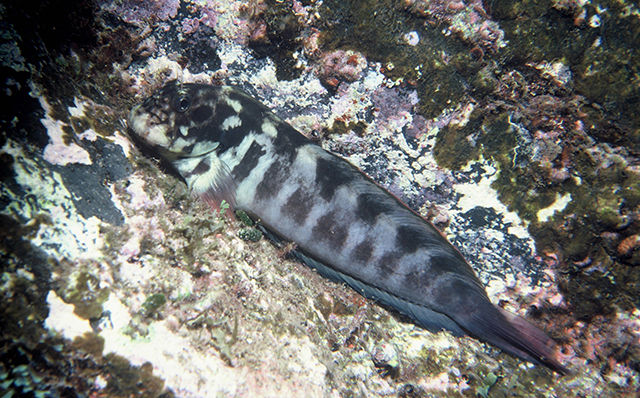| Blenniidae (Combtooth blennies), subfamily: Salariinae |
| 19 cm TL (male/unsexed) |
|
reef-associated; marine; depth range - 50 m |
| Atlantic Ocean: oceanic islands and along the coast of west Africa from Senegal to Angola. |
|
Dorsal spines (total): 12-13; Dorsal soft rays (total): 21-23; Anal spines: 2-2; Anal soft rays: 24-24. Head profile in front of eyes vertical; forehead projects in front of snout. Head, body and anal fin dark reddish brown, sometimes pale pinkish gray; lips and parts of pectoral and tail fins red (Ref. 26938). Larvae have terminal mouths and fang-like teeth for planktonic feeding; adults with comb teeth and ventrally located mouth for benthic feeding. Adult males with fleshy rugosities on anal-fin spines that secrete antimicrobial mucus (Ref. 94105). |
| Adults are restricted to shallow waters and dwell among rocks and coral reefs (Ref. 5298), where there is considerable wave action (Ref. 26938). They bite very severely, with their two very long and sharp canine teeth (Ref. 3157). Are grazers feeding on filamentous algae (Ref. 13442) and detritus. Larvae feed on plankton; during larval metamorphosis to adult stage, there is no feeding and rely on lipids stored in the liver (Ref. 94105). Oviparous. Eggs are demersal and adhesive (Ref. 205), and are attached to the substrate via a filamentous, adhesive pad or pedestal (Ref. 94114). Ophioblennius larvae are frequently taken in deep water column (Ref. 5298). Adult males with fleshy rugosities on anal-fin spines that secrete antimicrobial mucus applied to eggs being guarded (Ref. 94102). |
|
Least Concern (LC); Date assessed: 22 March 2011 Ref. (130435)
|
| traumatogenic |
Source and more info: www.fishbase.org. For personal, classroom, and other internal use only. Not for publication.

